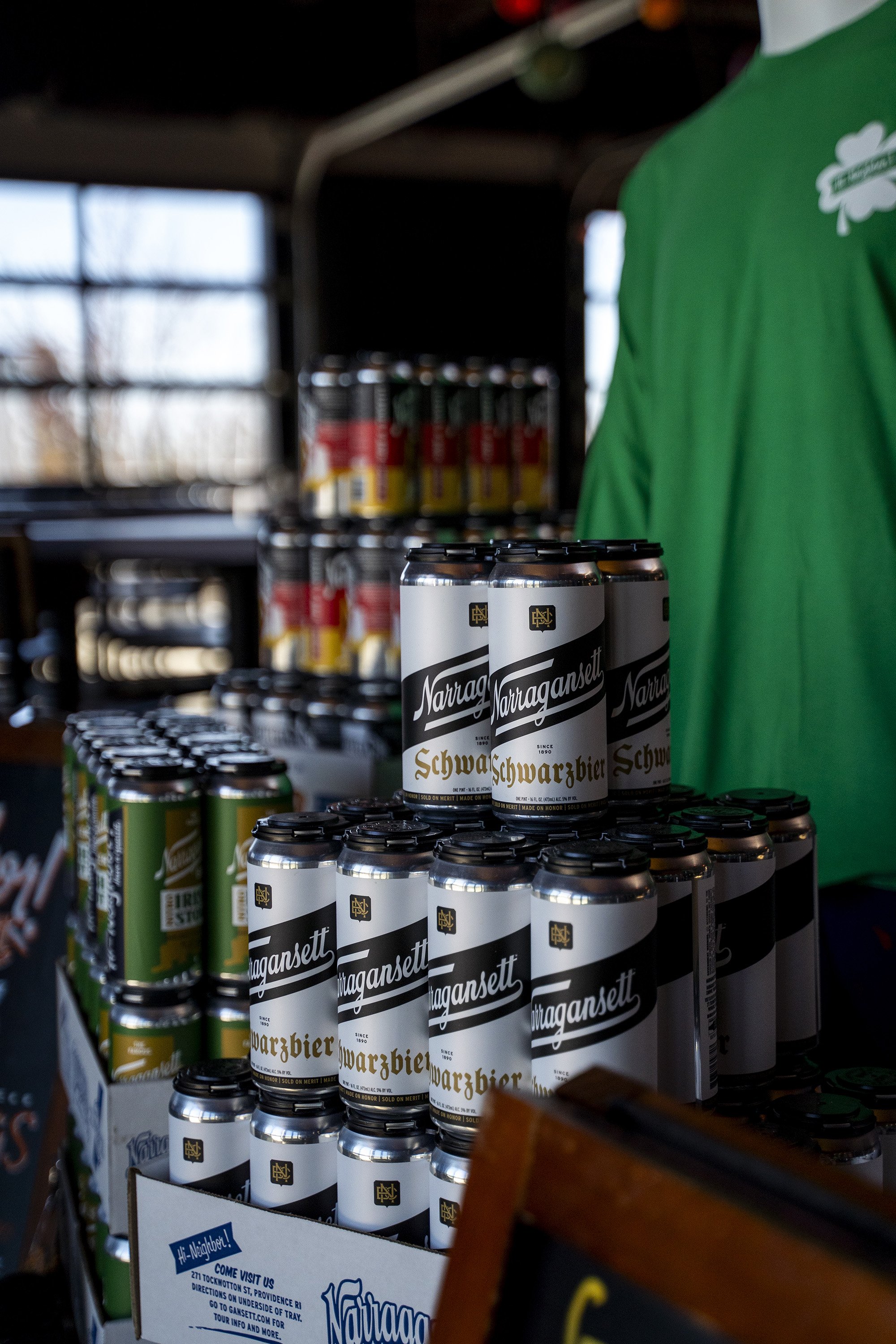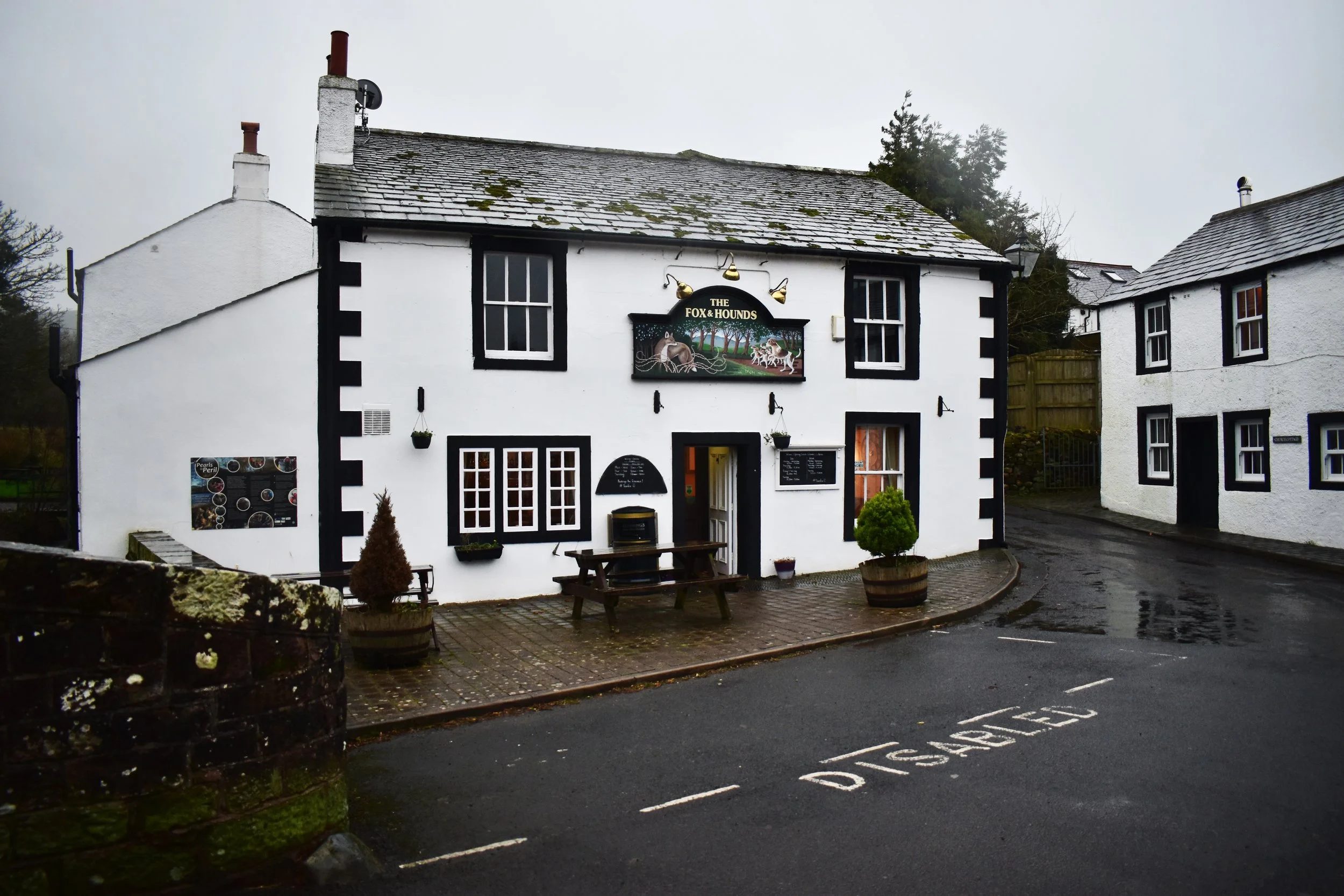You're Gonna Need a Bigger Boat — Narragansett Brewery in Providence, Rhode Island
As I wandered the floor of the Great American Beer Festival in September 2023, passing booths of hype breweries, prestige brands, newcomers, and beloved first-generation, legacy brewers, I spotted a name I hadn’t expected to see: Narragansett Beer. Not only was the brewery there, but it was pouring two styles I wouldn’t previously have associated with the brand: a Bohemian pilsner, and a porter.
I tasted the latter and enjoyed its classic profile—roasty but approachable, dry but not austere, with just a touch of coffee-like acidity from the dark grains— and quickly decided it was delicious. Tweeting my surprise, I immediately learned two things from helpful colleagues: Narragansett Porter has been brewed since 1916, and it was poured at the very first GABF back in 1982. I turned around and looked at their booth and asked myself: how well do I actually know this brewery?
If you live in the US, ‘Gansett is a brand you definitely feel like you know something about. They’re PBR (Pabst Blue Ribbon, a macro lager with an almost-obsessive cult following) without the hipster baggage, they’re the Jaws beer, they’re the dive bar darling brand that allows you to take the night off from pretentiousness without giving up taste. It’s an image the brewery itself is aware of and is happy to cultivate. Some of the time.
“There’s a lot of things you hear about Narragansett Lager, like ‘that’s what I drink at basement punk shows,’ or ‘that’s what my dad used to drink,” says Lee Lord, head brewer at Narragansett’s brewpub in Providence, Rhode Island. “It has a reputation as a macro adjunct lager.”
Photography by Melissa Jones
Lee is the taproom head brewer, but ironically, she doesn’t brew the flagship lager. We’ll talk about that more later. What does she brew? Oh, farmhouse ales, hazy IPAs, coffee milk stouts—all the styles a fan might have come to associate with ‘Gansett. Or maybe you’re asking yourself the same question I posed back in Denver: what on earth is Narragansett Beer?
It turns out there isn’t one answer, but two. And they’re about as different as can be.
***
Narragansett was founded in Cranston, Rhode Island—now a suburb of Providence, the state capital—in 1890 and brewed its beer on the original property for the next 90 years. Regional breweries sprang up in droves across the country in the late 19th century, and Narragansett became one of the major players in New England. They survived Prohibition partially because they were given a rare legal exception to continue brewing their Porter for “medicinal purposes.”
Falstaff Brewing—a century-old brewery that went out of business for good in 2005—purchased the brand in 1965, and Narragansett continued to operate as a mostly independent company until the original plant was shut down in July 1981 and production was moved to Falstaff’s plant in Fort Wayne, Indiana. This was functionally the end for what had once been the biggest brewery in New England. A changing market that saw the death of numerous heritage brands during the mid-to-late twentieth century, a lawsuit over anti-monopoly concerns that dogged the Falstaff acquisition, and the eventual move away from the region the brand was most connected with sealed Narragansett’s fate—it closed for good in 1983.
The closure of the brewery meant more to Rhode Island than just the loss of jobs and the need to find a new beer to drink at baseball games. This state is the smallest by land size in the country, and Narragansett had given them national recognition. Losing ‘Gansett was losing a core piece of the state’s identity.
Chris O’Leary, a beer writer who runs the popular Brew York website covering craft beer news in New York, grew up just a mile from the original brewery in Cranston. Even after the beer stopped flowing from the brewery, he remembers the building itself still holding meaning for residents until demolition began in 1998.
“I remember driving by when it was being demolished, and my parents would remark every time another wall came down,” he recalls. “A piece of Rhode Island was being stripped away.”
Mark Hellendrung, a 30-year veteran of various beverage industries, saw the Narragansett name languishing in the hands of subsequent owners in the decades following its departure from Rhode Island. He’d spent time with Ocean Spray and Snapple before moving into beer at Magic Hat Brewing Company, and thought he might be able to do something with a brand that was still loved and missed in New England.
“I’m the guy who had the bright idea to bring it back,” he says with a wry smile. “It was being completely neglected.”
““Yeah, you’ve slammed cans of this at your friend’s basement show, now come on over to the brewery. Come get weird with us.””
He purchased the brand from Pabst Brewing Company—makers of PBR, a brand Narragansett is now often compared to—with the help of investors in 2005. He had experience selling beverage brands, and now held a valuable property in a growing segment. The only problems? He had no beer, no one to brew it, and nowhere for it to be brewed.
“This was all a good story, but if the beer sucked, it would be a good story with a shitty ending,” he says.
A historian came to his aid. Hazel B. Turley is the author of Narragansett Brewing Company, published in 2007 by Arcadia Publishing, as part of their Images of America series. She heard about Mark’s planned revival of the brewery and made an auspicious connection for him: Bill Anderson, the final brewmaster at the old Cranston plant before it had shut down over two decades earlier. Anderson had moved on to Schlitz and eventually Anheuser-Busch after Narragansett collapsed, and “still had the old recipe rattling around in his brain,” according to Mark.
Mark knew his most valuable asset he possessed was the Narragansett name itself. Rather than throw a lot of investment money at building his own facility, he wanted to get [good] beer out to eager New Englanders, and quickly. He partnered with Genesee Brewing Company in New York to contract brew Narragansett Lager, the brand’s flagship beer. That flagship, along with Narragansett’s other high-volume products such as Del’s Shandy, are still brewed at Genesee today.
“I never had to build a $25 million brewery and build capacity for the 120,000 barrels a year we produce,” he explains. His attention instead went to rebuilding the brand itself. By the late 2010s, Mark had succeeded. It was only after revitalising the Narragansett name and building sales that he saw the value in having a place for fans to visit to build their connection with his beer.
“I think a brand needs to have a physical place and a soul,” he says.
He set about building a destination taproom overlooking the Providence River, and hiring a die-hard Jaws fan who’d spent the last decade brewing in New England craft breweries to brew an entirely new range of beers under the Narragansett banner.
***
Lee Lord is energetic and enthusiastic, and you get the feeling from talking with her that she’s as much a fan of her brewery as anyone. She started homebrewing in 2011, and took an unpaid position mopping floors and doing other grunt work at now-defunct Watch City Brewing in Massachusetts before eventually moving to the brewing team. From there she moved on to regional favourite Smuttynose Brewing, and eventually Cambridge Brewing. That’s where Mark found her when he came searching for a head brewer for his new brewpub.
Like many from the New England coastal area, Lee is a huge fan of Steven Spielberg’s 1975 blockbuster Jaws, a movie about a giant great white shark terrorising a small island town. One of the movie’s most iconic characters is Captain Quint, played by Robert Shaw, who drinks Narragansett Lager like it’s water while he and two others search for the shark from the deck of his fishing boat, Orca. A scene of him crushing a can of ‘Gansett to antagonise Richard Dreyfuss’s character conveys the self-serious absurdity that has made the character so likable for half a century. The small connection has been enough to make Narragansett Lager “the Jaws beer” for modern enthusiasts. And that includes Lee.
“It’s my favorite movie on the planet, and probably the reason I work for Narragansett now,” she says, only half-joking. “I got the call from Mark, and he was like, ‘Hey, I hear you’re the brewer who is obsessed with sharks and loves Jaws.’ He asked me to run his brewery, and I said, ‘Wait. I need to sit down and pinch myself. You mean my weird devotion to this movie just got me a brewmaster job at Narragansett?’”
Her hiring had far more to do with her acumen brewing modern craft styles than her love for the movie, but the latter certainly helped in getting her noticed. And she’s not alone in her devotion to Jaws and its de facto official beer. Shark Week is huge for the taproom each year, and Narragansett has partnered with the Shark Research Department at the University of Rhode Island to raise funds for research. Mark says their connection to the movie can actually cause a bit of tension for them—they don’t want to become the “Jaws Brewing Company”; he notes they have so much more to offer, which is why Lee was brought on.
The Narragansett taproom was opened in 2021. A curiosity of Rhode Island law prevents taprooms from serving any beer not brewed on premises, which means you can’t drink Narragansett Lager at Narragansett’s taproom. While it would be possible to brew small batches on site, Mark doesn’t want to step on Genesee’s toes. This raises no small amount of confusion from guests, but Lee says they try to encourage these devotees to try their Pre-Prohibition Lager or another light offering instead.
The rest of the beer list is where Narragansett’s second identity becomes clear. Lee didn’t come to Narragansett to brew the beer from Jaws—she came to brew everything else, and create a distinct personality for the Providence taproom. The tap list has included double IPAs, saisons, historical lager styles, or many other unexpected varieties since the taproom opened.
“Getting the customer base to see the ‘Gansett name along any beer style other than a lager has been a little bit tough,” Lee acknowledges. “You kind of see the light bulb go off in people’s heads when they sit down at the bar in Providence and go, ‘Oh, wow, she brewed a Bronze Age gruit.’ It’s like, what is ‘Gansett doing?”
The most easily-translatable beer to come out of the smaller facility is Musik Express, a hazy IPA hopped with Simcoe, El Dorado, and Mosaic, and named for a locally popular amusement park ride. The beer sells well in Gillette Stadium in Foxboro, Massachusetts, the home of the New England Patriots American football team. Despite name recognition and growing visibility, though, Lee is still only brewing about 3,500 hectolitres a year in Providence.
Not every beer Lee is producing on her 23 hectolitre system is a recent or rare style, of course. The porter I discovered at GABF couldn’t be much more traditional: it was first brewed over 100 years ago, but that original recipe disappeared with the death of the original brewery in the 1980s. When the Providence Historical Society reached out to Lee shortly after she started and wanted to brew a collaboration beer, she decided to revive the brand’s Porter with a new—well, old—recipe. She used a recipe discovered by British beer historian Ron Pattinson based on an 1822 Porter; nearly half the grist is brown malt, and no black malt is used at all.
““This was all a good story, but if the beer sucked, it would be a good story with a shitty ending.””
Porter as a style isn’t the standard it used to be in craft beer, and Narragansett sees that reflected in its annual release.
“It’s slow and steady, and we reach sort of…” she trails off, considering her words. “I don’t want to call them old. A mature customer base that doesn’t have the prejudices against porter that a lot of the younger beer drinkers do. It’s definitely a challenge, but I fight for it because it’s one of my favorites.”
Despite Lee’s skill for brewing modern craft styles, and the growing success of brands like Musik Express, customer prejudice is something Narragansett has had to overcome across its portfolio. When asked if there’s a barrier to overcome to get younger people to try Narragansett, Lee pauses to reflect before answering.
“I think so,” she says after a moment, before explaining that she thinks some of that barrier extends to craft beer as a whole at the moment, beyond her own brewery. “Breweries have to offer more. You can’t just let the beer speak for itself. It’s atmosphere, events, artwork, everything that piques someone’s interest. At ‘Gansett, we have this lager background akin to PBR, and we lean a little bit on our punk rock image. Yeah, you’ve slammed cans of this at your friend’s basement show, now come on over to the brewery. Come get weird with us.”
***
Getting weird is helping to expand Narragansett’s customer base, but the success of the brewery still depends upon selling a few million gallons of the flagship lager every year—the iconic beer represents 80% of the brewery’s sales. It’s a good example of the style, but how does it compare to the original that disappeared decades ago? Mark has talked to a lot of old-timers who remember the original, and the responses are consistent.
“One is, ‘This tastes exactly like I remember,” he explains. “The other is, ‘This tastes nothing like I remember.’”
Chris adds that when the beer first relaunched in the 2000s, he’d see more old folks than young drinking it in Rhode Island bars, but that’s begun to shift. Its release close to home was predicated on nostalgia, but savvy marketing outside its home region positioned it differently.
“When it launched here in New York, it launched as a PBR replacement,” he explains. “The younger generation saw it as a cool, classic American lager. There are things about Rhode Island that don’t make sense, but at least this beer does.”
Balancing the marketing tastes and flavor preferences of an older generation with younger drinkers, and meeting the needs of diverse consumer bases near home and farther afield are challenges for any midsize brewery. For Narragansett, there are ways those challenges are both exacerbated and alleviated by the brewery’s unique dual identity. It’s a challenge Lee doesn’t see going away soon, but that tension is part of the fun for her.
“One foot in the past and one foot in the future of beer, however scary both paths can be sometimes—that’s where I want to be,” she says. “I just want to be reinforcing the idea that beer can be fun. I like it when people stick their nose in the glass, do the swirl, take their notes. But please smile.”
Narragansett Beer existed for a century, disappeared at the hands of 20th century consolidation, and was reborn at a time when American craft beer was still trying to figure out exactly what it was going to be after its own coming of age in the late ‘90s. The industry’s in the process of needing to figure that out again as a changing market once again kicks off a craft beer identity crisis.
Narragansett is in the unique position of having multiple identities of its own. Whether taking notes in the taproom with noses deep in the glass or throwing back cans of the flagship at ballgames and concerts—Narragansett wants you to do both. Just remember to smile.











































